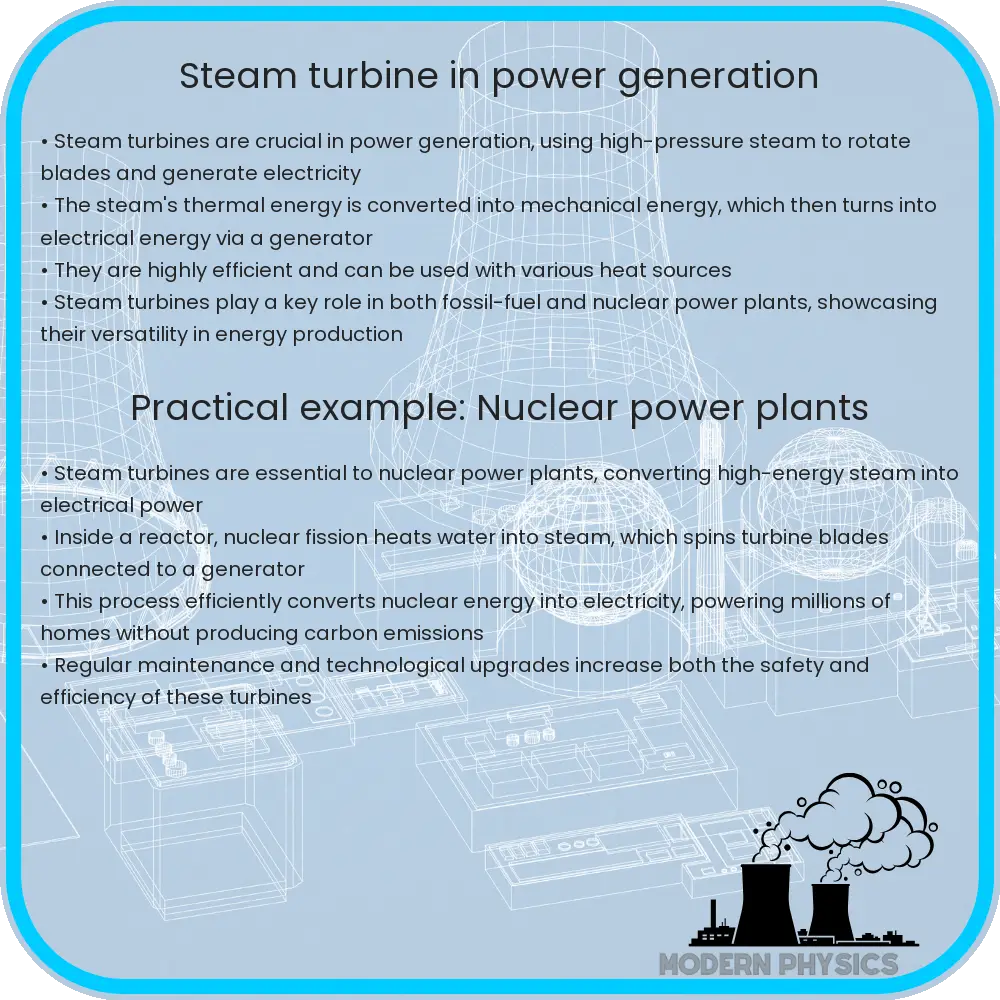Learn how steam turbine efficiency is assessed and enhanced, exploring factors from steam conditions to blade design impacting performance in power generation.

Understanding Steam Turbine Efficiency
Steam turbines are a critical component in various industrial processes, including electricity generation in thermal power stations. The efficiency of a steam turbine measures how effectively it converts the energy from steam into mechanical energy and, eventually, electricity. This efficiency is influenced by several factors, including the principles of fluid dynamics and thermodynamics. In this article, we will explore these factors and how they impact the turbine’s energy output.
Basics of Steam Turbine Operation
A steam turbine operates on the basic principle of converting thermal energy from steam into mechanical energy through expansion. As high-pressure steam passes through the turbine’s blades, it expands and cools. This expansion drives the turbine shaft, producing rotational motion which can be converted into electrical energy via a generator.
Key Factors Affecting Steam Turbine Efficiency
- Steam Quality: The quality of the steam, encompassing its temperature, pressure, and moisture content, significantly affects turbine performance. Higher temperatures and pressures typically lead to higher efficiencies.
- Turbine design: The aerodynamic design of the blades, the material used in construction, and the overall configuration of the turbine (e.g., impulse vs. reaction turbine) also play a crucial role in efficiency.
- Exhaust Losses: Losses occur when the steam exits the turbine at a pressure above the ambient pressure. Minimizing these losses can enhance efficiency.
Calculating Steam Turbine Efficiency
The efficiency (\(\eta\)) of a steam turbine can be commonly estimated using the formula:
\[ \eta = \frac{W_{out}}{Q_{in}} \]
where:
- \(W_{out}\) is the mechanical power output (work done by the turbine), typically measured in megawatts (MW).
- \(Q_{in}\) is the heat energy input from the steam, measured in megawatts (MW).
Moreover, the turbine’s isentropic efficiency (considering an ideal, reversible process) can be defined as:
\[ \eta_{isen} = \frac{h_1 – h_2}{h_1 – h_2s} \]
Here, \(h_1\) and \(h_2\) are the specific enthalpies of the steam at the inlet and outlet of the turbine, respectively, and \(h_2s\) is the specific enthalpy at the outlet for an isentropic process.
To further break down these calculations, taking into account real-world factors like friction, blade design, and steam leakages is essential. These factors degrade the ideal performance predicted by theoretical efficiency calculations.
Improving Steam Turbine Efficiency
Improving the efficiency of a steam turbine involves optimizing several aspects:
- Enhancing steam conditions: This might involve increasing the inlet steam pressure and temperature and reducing the exhaust pressure to get as close to the theoretical Carnot efficiency as possible.
- Advanced blade design: Developing blades with improved aerodynamics and using materials that can withstand higher temperatures and pressures can also lead to better performance.
- Reducing internal losses: Implementing better seals and reducing spacing between stationary and moving parts can minimize steam leakage and internal frictions.
Steam turbines play a pivotal role in efficient power generation, especially in large scale thermal power stations. By understanding and enhancing the efficiencies of these turbines, significant advancements in energy conservation and operational cost reduction can be achieved, echoing the drive towards more sustainable industrial practices.
Challenges in Achieving High Efficiency
Despite technological advances, there are inherent challenges in achieving peak efficiency in steam turbines:
- Material Limitations: The materials used in turbine construction must withstand extreme temperatures and pressures, possibly leading to higher costs and engineering complexities.
- Thermal Stresses: Rapid temperature changes can cause thermal stresses in turbine components, risking damage and reducing their lifespan.
- Operational Wear: Continuous operation leads to wear and tear, which over time decreases efficiency and increases the need for maintenance.
Future Trends in Steam Turbine Technology
Looking forward, the development of steam turbines involves several exciting trends:
- Integration of Renewable Energy: With the rise of renewable energy sources, steam turbines are increasingly used in conjunction with solar thermal and bioenergy systems to ensure steady power supply despite variable conditions.
- Use of Artificial Intelligence: AI can optimize turbine performance in real-time, predicting maintenance needs and operational adjustments to improve efficiency and extend equipment life.
- Material Innovations: Advances in materials science promise more resilient components that can perform under higher stresses while maintaining efficiency.
These innovations not only aim to increase the efficiency of steam turbines but also make them more adaptable to modern energy demands and environmental concerns.
Conclusion
Understanding the efficiency of steam turbines is crucial for enhancing power generation and achieving energy sustainability. The efficiency of a steam turbine is influenced by factors such as steam quality, turbine design, and operational practices. While calculating the turbine’s efficiency gives insights into its performance, actual improvements require tackling challenges like material limitations and operational wear. Looking ahead, integrating advances in technology such as AI and new materials can lead to breakthroughs in turbine performance. By continuously evolving and adapting, the steam turbine remains a vital component in the quest for efficient and sustainable energy production.
